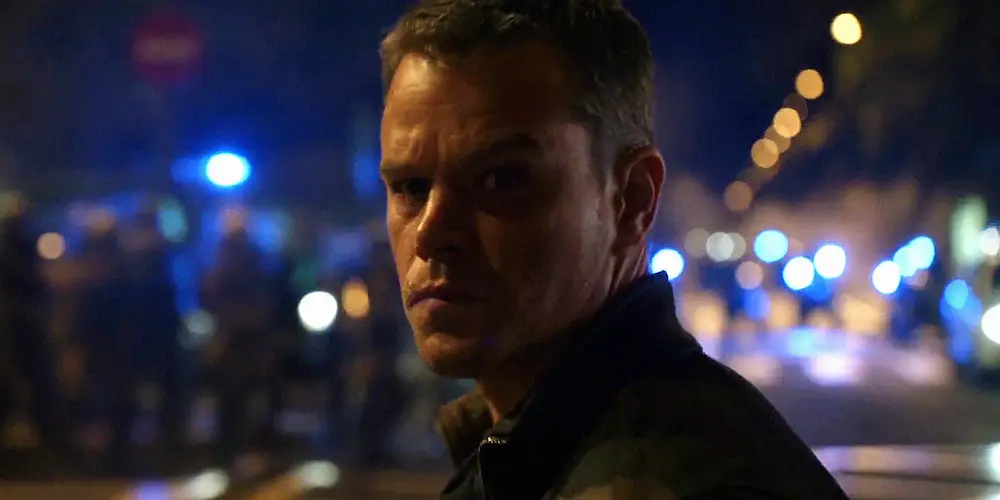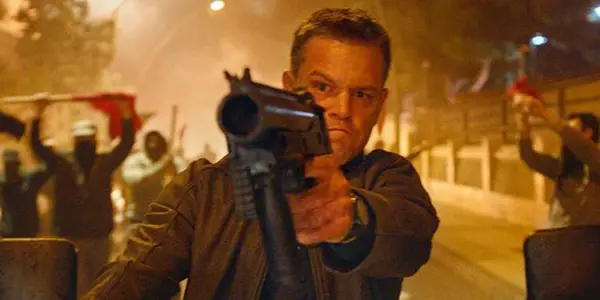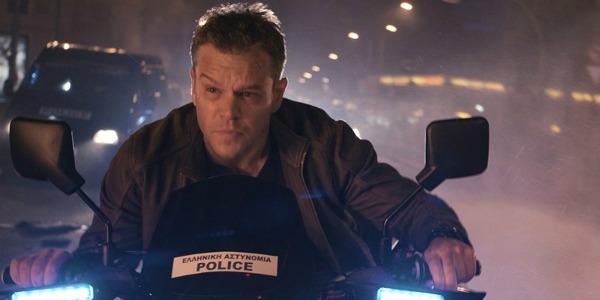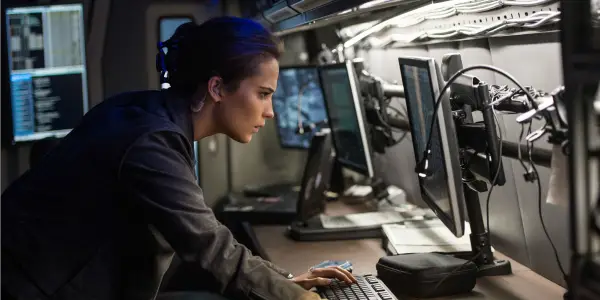Beyond The BOOM Pt. 3: Storytelling With Sound In JASON BOURNE

Joseph Klingman is a college student of the Peach State,…
A largely-overlooked but critical element in an action film is its ability to tell a story with sound. Dialogue and musical score notwithstanding, sound cues and effects are incredible tools for storytelling in the genre; subtly adding depth and detail without ever compromising action or hogging screen-time. Given recent advances in the field of sound technology, filmmakers are even now using these techniques to great advantage in crafting critically-acclaimed action films.
On this third and final part of the series (see Parts One and Two), I’ll look at the recent action film Jason Bourne, evaluating its use of storytelling by sound. Two prior action films, George Miller’s Mad Max: Fury Road (2015) and Kathryn Bigelow’s The Hurt Locker (2009), serve as an aural rubric.
Action Sound Recap
For reference, my examination of these two prior films found six ways in which sound can be used effectively in the action genre. Mad Max: Fury Road, for its high-speed adventure, uses sound to establish the tone and aura of an unfamiliar world, to identify specific factions and important characters, and even to actively drive the plot along (pun acknowledged).
The Hurt Locker, with its contrastingly realistic battle-suspense, uses sound cues to describe specific locations within an already familiar world. It also uses these cues to isolate the audience in the immediate experiences of the characters, and to reinforce that sense of realism necessary to sustain its visceral tension.
Despite these films being on opposite sides of the action spectrum, both actively employ sound cues to pull the audience into the fray of combat. The results of these techniques show in numerous awards, nominations, and critical praises for both films.
Jason Bourne’s Return
To this playing field, action director Paul Greengrass brings his newest film Jason Bourne, the awaited sequel to an already successful four-film run. More than a decade prior, the series’ original director, Doug Liman, first brought the titular character to life as an amnesiac assassin (played brilliantly by Matt Damon) on the run from his U.S. Government employers in The Bourne Identity (2002). In The Bourne Supremacy (2004), Greengrass entered to direct Bourne’s resurgence from hiding and continued with The Bourne Ultimatum (2007) to put the character back on U.S. soil, tasked with crippling the secret agency that trained him. This last film managed to run off with, of all things, an Oscar each for Sound Mixing and Sound Editing.

Greengrass stepped back from the series’ directing helm, letting former co-writer Tony Gilroy take lead on 2012’s The Bourne Legacy, a side-story following fellow agent Aaron Cross (Jeremy Renner) in his own escape from the agency. From there fans were left wondering whether either the original director or the original character would return. Greengrass and Damon answered in true Hollywood fashion: apprehensive, hesitant at first, but after long last revealing a fifth film in the works.
The end product (released only in July) is stylized simply as Jason Bourne, and sees the central character return to his series as grizzled, aging expatriate, hiding in the shadows of Eastern Europe. After years as a street brawler, keeping his combat skills sharp while paying physical penance for his guilt, Bourne is awakened by the call of an old friend from the agency and the chance to discover more of his still-hazy past.
This open rendezvous puts the agency back on Bourne’s trail, and Bourne on a path to the U.S. once more, slipping easily into his role of cloak-and-dagger expert as he tracks down answers in a new, post-Snowden homefront. (Minor, yet unavoidable SPOILERS FOLLOWING. Again, I assume you’ve seen the film, and if not, you’ve been warned.)
How Did It Sound?
And now the evaluation: In simplest terms, Jason Bourne uses many of the same techniques for storytelling-by-sound seen (or heard) in the two previously-reviewed action films. However, rather than being put to full use, these techniques are muted, perhaps even bridled, and appear as flattened minor additions to the film’s plot development. Sound cues are used to establish the opening world (present-day Greece) and to contrast later environments, but they only serve to recall familiar stereotypes.
The film finds Bourne first in a small village, familiarly third-world; seagulls alone communicate its proximity to some ocean coast, and the chatter of kids playing street soccer recalls countless impoverished locales. Soon after, the audience is treated to the multilingual roar of Bourne’s street fights, and the squeals of old vehicles down bumpy dirt roads. The streets of Athens at night are pulled from recent news: we hear the massive riot chants, and the answering wails of foreign police sirens. Lines of riot shield officers crunch and crackle, pelted by the mobs.

Bourne’s path through major cities in Germany, Britain and the U.S. are sonically accompanied by less hostile, more English-sounding crowd chatter, and familiar police cruiser siren calls, but are otherwise not distinguished from each other. The several appearances of convention crowds and paparazzi are a welcome comfort to the earlier riots, but are heard only as expected.
Sound is also used to identify faction in the film, but really only to express the “Against Bourne” team. Cars, SUVs, and vans used by the agency forces or their lackeys are almost always heard with engines growling, no matter the speed or obstacle. Nefarious research bays are uniformly coated with the sound of techs busy analyzing behind computer terminals, and agency higher-ups on the move seem to be followed by similar chatter.
In a few instances, sound is allowed to put the audience sonically in the immediate moment with Bourne. Flashbacks, as per custom, are echoed and whooshed in memory; and beyond this, Bourne’s breath, and perhaps even heartbeat, can sometimes be heard at the turn of a significant event. Yet these tricks have been heard before, and are unremarkable in their use here.
Sound is even employed to directly signal plot movement or new information, but this technique comes almost unilaterally in the form of overused computer noises. Every digital device seems to make noise, and every new data pop-up is marked with a blip, ping, or some other sound. While functionally effective, the use of such sounds here is somewhat unrealistic and is accompanied by a few on-screen cheats – thus making any info passed by them just a bit too much on-the-nose.
A few unique uses of sound are worthy of mention, for their effectiveness at communicating what are likely the most important points in the film’s plot. Most notably, the use of a simple cell-phone ring is turned into an unmistakable mark of the agency. Important officials and hitmen alike receive the ring, and even Bourne must literally answer the call, a painful reminder of his remaining ties to a shadowy past.

Beyond this, sounds are used to highlight the weapons in play during combat sequences. Guns are loud, each single shot (rather than a simple hail of lead) used to punctuate the moment. And a later fight scene is uniquely enhanced by the sounds of two unorthodox weapons: a length of cable, and a kettle. The point here: combat is brutal, visceral, up-close and always decisive.
Perhaps the most profound sound technique is actually that of strategic silences, always following moments of Bourne’s unrestrained combat skills. With what is shown of the character during these moments, the viewer is let in on the paradox that Bourne himself can find silence, or some sense of peace, only after returning to his former ways. This inner paradox, over the course of the film, is shown to be the most significant addition to Bourne as we know him.
Conclusions
To conclude then, Jason Bourne uses many of the elements of storytelling by sound seen in Mad Max: Fury Road and The Hurt Locker. But, rather than achieving the level of aural detail and innovation of these films, the former largely reverts to well-used stand-in sounds and stereotypes, dime-a-dozen in countless action flicks and other films. Such use of sound cue techniques seems to mirror the critical reception for the film as a whole: while it does trick for a Bourne film (and though a few things do stand out within) it ultimately fails to stand out in any memorable way.
Nonetheless, this article series’ point still stands: creative use of sound cues have become a powerful and integrated tool for storytelling in the action genre. Many directors are already putting it to good use; and with no shortage of action films in the near future, it is this viewer’s hope that some more good stories are out there to be heard as well as seen.
What stood out the most about the sound of Jason Bourne? How do you think it stacked up to the other two films? Tell me in the comments!
See the full Film Inquiry review of Jason Bourne here.
Does content like this matter to you?
Become a Member and support film journalism. Unlock access to all of Film Inquiry`s great articles. Join a community of like-minded readers who are passionate about cinema - get access to our private members Network, give back to independent filmmakers, and more.
Joseph Klingman is a college student of the Peach State, a native of the Sunshine State, and the possessor of an ever-contemplative State of Mind. He spends his time on many hobbies in numerous media, but finds himself always picking about the wonderful worlds of film and storytelling.













